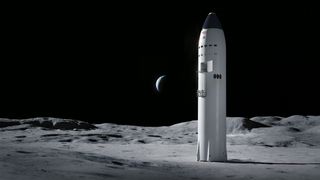 NASA's $25.4 billion budget for 2023 includes funding for second moon lander alongside SpaceX Starship
NASA's $25.4 billion budget for 2023 includes funding for second moon lander alongside SpaceX Starship
28/12/2022, 10:22
By Elizabeth Howell
published about 18 hours ago
NASA will receive $25.4 billion in 2013, less than the White House's request.

This SpaceX concept shows the company's massive Starship vehicle on the moon. (Image credit: SpaceX)
NASA can proceed with finding a second moon lander besides Starship.
Congress approved $25.384 billion for NASA in its $1.7 trillion omnibus bill passed Dec. 23, including full funding for a second Artemis program moon lander to supplement SpaceX's Starship, according to SpaceNews (opens in new tab).
The overall allocation, however, is less than the nearly $26 billion White House request put forward in March.
[url=https://popup.taboola.com/en/?template=colorbox&utm_source=futureplc-space&utm_medium=referral&utm_content=thumbnails-a-mid:Mid Article:]Sponsored Links[/url]
Babbel secret: An Expert Explains The Success of This AppBabbel
Two main teams have signed up to offer Human Landing Services for the moon in the latest solicitation, which closed Dec. 6. Blue Origin leads the bid for their "National Team (opens in new tab)," which also includes Lockheed Martin, Draper, Boeing, Astrobotic, and Honeybee Robotics. Northrop Grumman is on a tea led by Leidos Dynetics (opens in new tab).
Congress tasked NASA to find a second company following a troubled HLS bidding process in 2020-21 that saw SpaceX selected as the sole entrant, which sparked protests and an overturned lawsuit.
Related: NASA's Artemis 1 moon mission explained in photos
NASA's allocation is 5.6% more than the $24.041 billion the agency received in fiscal year 2022, but at current inflation rates the agency has fewer dollars to work with compared to last year.
While NASA's exploration program and space operations effectively received full requests, science did not.
"Science overall gets $7.795 billion in the bill, nearly $200 million below the request. Planetary science and heliophysics get slightly more than requested, while astrophysics, Earth science and biological and physics sciences suffer cuts," SpaceNews wrote.
Near Earth Object Surveyor was one of the more notable changes, receiving $90 million (more than double the $40 million NASA request) in an effort to bring it into space sooner rather than later. NASA announced Dec. 6 that the mission had passed a key decision point on its road to space.
Congress expressed concern about NASA's plans to delay the launch to 2028, noting the agency is behind on its mandate to find 90 percent of objects roughly 460 feet (140 meters) in diameter. But agency sources told SpaceNews the extra money is not enough to launch on time in 2026.
Elizabeth Howell is the co-author of "Why Am I Taller (opens in new tab)?" (ECW Press, 2022; with Canadian astronaut Dave Williams), a book about space medicine. Follow her on Twitter @howellspace (opens in new tab). Follow us on Twitter @Spacedotcom (opens in new tab) or Facebook (opens in new tab).
Join our Space Forums to keep talking space on the latest missions, night sky and more! And if you have a news tip, correction or comment, let us know at: community@space.com.
Elizabeth Howell
Staff Writer, Spaceflight
Elizabeth Howell, Ph.D., is a staff writer in the spaceflight channel since 2022. She was contributing writer for Space.com (opens in new tab) for 10 years before that, since 2012. Elizabeth's reporting includes an exclusive with Office of the Vice-President of the United States, speaking several times with the International Space Station, witnessing five human spaceflight launches on two continents, working inside a spacesuit, and participating in a simulated Mars mission. Her latest book, "Why Am I Taller?", is co-written with astronaut Dave Williams. Elizabeth holds a Ph.D. and M.Sc. in Space Studies from the University of North Dakota, a Bachelor of Journalism from Canada's Carleton University and (soon) a Bachelor of History from Athabasca University. Elizabeth is also a post-secondary instructor in communications and science since 2015. Elizabeth first got interested in space after watching the movie Apollo 13 in 1996, and still wants to be an astronaut someday. Mastodon: https://qoto.org/@howellspace
published about 18 hours ago
NASA will receive $25.4 billion in 2013, less than the White House's request.

This SpaceX concept shows the company's massive Starship vehicle on the moon. (Image credit: SpaceX)
NASA can proceed with finding a second moon lander besides Starship.
Congress approved $25.384 billion for NASA in its $1.7 trillion omnibus bill passed Dec. 23, including full funding for a second Artemis program moon lander to supplement SpaceX's Starship, according to SpaceNews (opens in new tab).
The overall allocation, however, is less than the nearly $26 billion White House request put forward in March.
[url=https://popup.taboola.com/en/?template=colorbox&utm_source=futureplc-space&utm_medium=referral&utm_content=thumbnails-a-mid:Mid Article:]Sponsored Links[/url]
Babbel secret: An Expert Explains The Success of This AppBabbel
Two main teams have signed up to offer Human Landing Services for the moon in the latest solicitation, which closed Dec. 6. Blue Origin leads the bid for their "National Team (opens in new tab)," which also includes Lockheed Martin, Draper, Boeing, Astrobotic, and Honeybee Robotics. Northrop Grumman is on a tea led by Leidos Dynetics (opens in new tab).
Congress tasked NASA to find a second company following a troubled HLS bidding process in 2020-21 that saw SpaceX selected as the sole entrant, which sparked protests and an overturned lawsuit.
Related: NASA's Artemis 1 moon mission explained in photos
NASA's allocation is 5.6% more than the $24.041 billion the agency received in fiscal year 2022, but at current inflation rates the agency has fewer dollars to work with compared to last year.
While NASA's exploration program and space operations effectively received full requests, science did not.
"Science overall gets $7.795 billion in the bill, nearly $200 million below the request. Planetary science and heliophysics get slightly more than requested, while astrophysics, Earth science and biological and physics sciences suffer cuts," SpaceNews wrote.
Near Earth Object Surveyor was one of the more notable changes, receiving $90 million (more than double the $40 million NASA request) in an effort to bring it into space sooner rather than later. NASA announced Dec. 6 that the mission had passed a key decision point on its road to space.
Congress expressed concern about NASA's plans to delay the launch to 2028, noting the agency is behind on its mandate to find 90 percent of objects roughly 460 feet (140 meters) in diameter. But agency sources told SpaceNews the extra money is not enough to launch on time in 2026.
Elizabeth Howell is the co-author of "Why Am I Taller (opens in new tab)?" (ECW Press, 2022; with Canadian astronaut Dave Williams), a book about space medicine. Follow her on Twitter @howellspace (opens in new tab). Follow us on Twitter @Spacedotcom (opens in new tab) or Facebook (opens in new tab).
Join our Space Forums to keep talking space on the latest missions, night sky and more! And if you have a news tip, correction or comment, let us know at: community@space.com.
Elizabeth Howell
Staff Writer, Spaceflight
Elizabeth Howell, Ph.D., is a staff writer in the spaceflight channel since 2022. She was contributing writer for Space.com (opens in new tab) for 10 years before that, since 2012. Elizabeth's reporting includes an exclusive with Office of the Vice-President of the United States, speaking several times with the International Space Station, witnessing five human spaceflight launches on two continents, working inside a spacesuit, and participating in a simulated Mars mission. Her latest book, "Why Am I Taller?", is co-written with astronaut Dave Williams. Elizabeth holds a Ph.D. and M.Sc. in Space Studies from the University of North Dakota, a Bachelor of Journalism from Canada's Carleton University and (soon) a Bachelor of History from Athabasca University. Elizabeth is also a post-secondary instructor in communications and science since 2015. Elizabeth first got interested in space after watching the movie Apollo 13 in 1996, and still wants to be an astronaut someday. Mastodon: https://qoto.org/@howellspace
_________________

- Brussels opens Pandora's box with €100 billion budget top-up request
- Πωλούνται εφημερίδες τής 23-2-023, τής 15-11-1983, της 22-2-2023, τής 19-2-2023, της 25-2-2023, τής 21-2-2023 και της 20-2-2023
- Brussels’ trillion-euro budget may need expanding, Commissioner says
- 6 Big Purchases That Can Save Energy and Money at Home (Plus Budget-Friendly Options)
- Argentines Reject President Milei’s Veto on University Funding
Δικαιώματα σας στην κατηγορία αυτή
Μπορείτε να απαντήσετε στα Θέματα αυτής της Δ.Συζήτησης





